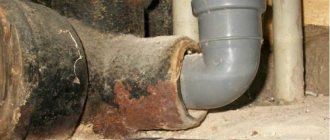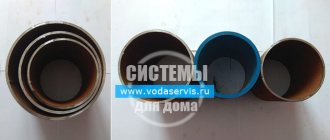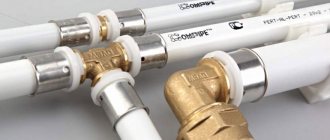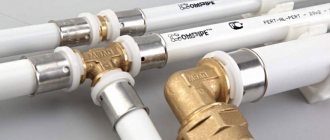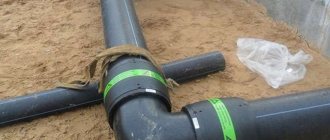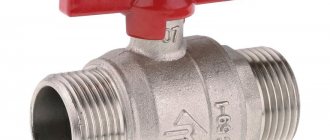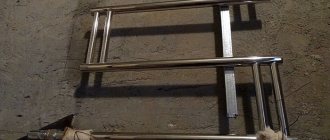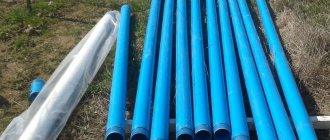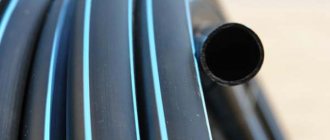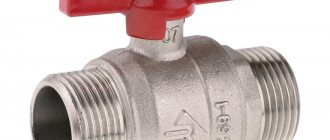When is such a connection needed?
The need for connections of this type arises in the following cases:
- connecting to an existing metal (most often cast iron) riser of a polymer liner from a sink, sink, bathtub, etc.;
- installation of steel reinforcement on the HDPE pipeline;
- connection to a system with a high operating temperature, which low-density polyethylene (HDPE) cannot withstand;
- connection to the metal outlet of a garden irrigation system from the house;
- a tie-in into the central highway, the wiring to which passes through an area with increased load. In this place, stronger metal segments are used, and polymer pipes go up to it.
Connecting HDPE to a metal pipe
HDPE pipe connections used with metal threads are made mainly to connect HDPE to metal pipes. The need for this type of connection may arise when installing HDPE with metal pipes that are difficult to dismantle (cast iron risers), or when connecting a water supply system to a central main (high pressure), where strong metal composite pipes are used at the outlet, and branches already go from them from polymers.
For the type of connections shown, double-sided fittings are designed, one side of which is threaded, and the other has a compression value. This type of fittings is connected using the principle of a “collet connection with a coupling”. A dismountable section of the fitting is mounted on a pipe made from HDPE, secured by welding, and later the threaded element is attached to the metal pipe. If it is impossible to use the welded connection principle, a flange system is used. An unlimited selection of pipe fitting models can be adapted to suit any need.
Advantages and disadvantages of such a connection
Preference is given to such a connection due to the unique characteristics and high performance properties of HDPE products. They got their name thanks to the technology of manufacturing polyethylene under low pressure.
Compared to products made from LDPE (high-density polyethylene), HDPE has a higher density and better strength characteristics.
- Like all types of plastic, it is not subject to corrosion and the destructive effects of chemically aggressive substances, and has a smooth surface that allows it to maintain high throughput throughout the entire period of operation.
- It has frost resistance (withstands -50˚) and low thermal conductivity.
- Polyethylene products are lightweight and easy to assemble. They are cheaper than polypropylene pipes and metal-plastic analogues.
- They are used in the water supply system, when laying external water supply to the house, and installing a sewer network.
The disadvantages of HDPE products include intolerance to high temperatures (begins to soften at 80˚). Because of this, it is not recommended for use in heating and hot water supply systems, where it is better to use metal-plastic.
Polyethylene is very susceptible to UV rays, therefore it is recommended only for laying underground, in dark rooms.
This video demonstrates the characteristics of low pressure pipes:
Connection methods
The transition is carried out in two ways:
- detachable (through special adapters in the form of threaded couplings, bends, tees);
- one-piece (using either butt welding or through electric fittings that, when current is applied, can melt the welded surfaces, after cooling which a reliable joint is obtained).
Detachable
Classic threaded connection. Turns are cut into the metal with a die, and a transition fitting is screwed onto them, which has an external or internal thread at one end, and a seat for a plastic element at the other. Today's advanced compression fittings require virtually no tools or equipment for assembly.
Docking using flanges. Used when connecting pipeline fittings made of steel that have a flange or the possibility of welding it. For such connections, a polymer bushing with a separately attached flange was invented. It is put on the sleeve, it is welded to the end of the HDPE pipe. Next, its flange is bolted to a similar part of the connecting element.
The photo shows the bushing:
Flange for sleeve:
One-piece
Based on the welding method of joining components. A distinction is made between butt welding, which is used when connecting pipes and fittings of the same diameter and thickness, and welding through polyethylene-steel electrical adapters using special equipment.
Detachable connections
This is a structure that can be dismantled if necessary. The HDPE pipe is connected with fittings that are leak-tight. They are reusable, so you can connect and disconnect them many times. A positive property of a detachable connection is considered to be beauty in installation. This work does not require the purchase of special equipment. This installation method allows you to save money, since the elements themselves are inexpensive.
If a certain interval needs to be replaced, there is no need to dismantle the entire system. It is enough to remove the damaged area and place a new component there. If the installation was installed correctly, the connection is sealed. It is better to make permanent those areas that are subject to maximum load. There are two types of detachable connections:
- Using compression fittings. This method is one of the most reliable and simple. It is important to secure the coupling to the pipes so that it is firmly installed.
- Socket connection. It is rarely used, since this method does not provide optimal performance. One end of the product should be slightly wider than the other. A separately taken pipe is inserted into the wide end of another with its narrow end. To ensure tightness, special gaskets are placed between these objects. Fitting connections are used most often today.
Diameter standards
The main dimensional parameter of a HDPE pipe is the outer diameter. In accordance with GOST, it is indicated in the labeling of domestic products. The size range is set in a certain sequence, the most used starts from 16 mm and goes up to 110 mm.
When installing yourself, it is important to understand how to combine sections of pipe products made of steel and HDPE. There is a specially designed table of their sizes suitable for each other:
What are HDPE pipes?
HDPE is produced by extrusion from polymerized ethylene. Finished products in the form of pipes are used for the construction of highways for the transportation of liquid and gaseous media. This can be natural fuel, drinking or industrial water, wastewater. The classification is also based on the permissible pressure inside the channels. High-pressure ones cope with 2.5 MPa, low-pressure ones with 0.6 MPa, non-pressure ones are designed for the installation of gravity wires.
The basic technical characteristics of HDPE pipes are as follows:
- the operating temperature range is presented as -20-+40 degrees Celsius;
- the maximum thermometer readings are +70 degrees Celsius;
- strength up to 38 MPa;
- pressure ranging from 6 to 25 Atm;
- diameter up to 120, less often up to 150 mm.
In addition to the construction of highways using HDPE products, protection devices for electrical wiring are allowed. The product lasts for about 50 years. On trading floors, pipes are presented in the form of coils of 100, 200 and 1000 m or sections of up to 12 m.
Coils and cut products from HDPE Source billionnews.ru
Advantages and operational features of HDPE pipes
The versatility regarding the use of HDPE pipes is explained by the tightness, elasticity and resistance of the material to aggressive operating conditions. The internal surface of the products is smooth, which virtually eliminates the risk of accumulation of sludge and deposits, ensuring efficient use of the wire throughout its entire service life.
Also, the advantages of such products include the following properties:
- corrosion resistance;
- inertness to the chemical environment;
- lightness (almost 6 times less than steel);
- plasticity (movement without depressurization is allowed by 5-7% of the initial position, which is important in case of freezing of transported liquids);
- resistance to water hammer;
- simplicity regarding installation and maintenance;
- low cost.
HDPE wire for drinking water Source otoplenin.ru
The material is environmentally friendly and allows for self-installation. But there are disadvantages that need to be considered before choosing. It is unacceptable to use HDPE pipes for heating equipment. To lay channels in the ground, its mobility must be taken into account. Ultraviolet radiation negatively affects the technical characteristics of the material.
Determination of Applicability
To simplify the selection of low-density polyethylene pipes, manufacturers mark the finished product and apply a color indicator. Thus, a yellow longitudinal stripe indicates the purpose for a gas pipeline, red and blue - for cold and hot water, respectively. Regarding the maximum pressure, the designations PE 63, PE 80 and PE 100 are applied. Underneath this lies 6.3, 8 and 10 MPa.
Marking on finished products Source dpm-system.ru
Another method (also indicated in the labeling) involves tracking the SDR indicator. This is a dimensional coefficient that hides the ratio of the cross-section to the wall thickness. It looks like this (SDR/pressure limit):
- For pressure main systems, gas pipelines and sewers, the following indicators are relevant: 6/25, 7.4/20, 9/16, 11/12.
- Irrigation installations and low-pressure water pipelines: 13.6/10, 17/8, 17.6/7.
- Water supply to low-rise buildings is provided by pipes with SDR 21 and a permissible pressure of 6 Atm.
For internal service of houses with drinking water and gravity sewerage systems, products with a size coefficient of 26, 33 or 41 are used. This corresponds to a pressure of 4 to 5 Atmospheres.
Step-by-step technique for connecting pipes with your own hands
The technology for converting HDPE to metal includes the following stages:
- choosing a connection method;
- determination of section sizes and material lengths;
- purchase of pipes, fittings;
- tool preparation;
- connection installation;
- verification tests.
- necessary tools and materials
The minimum set of tools includes:
- wrenches, adjustable wrenches;
- mites;
- pipe cutter;
- thread cutter;
- welding machine if necessary.
Materials are purchased depending on the volume of work, pipes - taking into account 10% of losses to waste.
Work progress
- Threaded detachable connections begin with the preparation of the steel end: it is cut, aligned, and threaded.
- Then, using a winder, the adapter fitting is screwed on by hand.
- At the other end of the fitting, plastic is installed using a crimp nut.
- Use a wrench to tighten the fitting onto the thread.
Installation features
Polyethylene fittings are used mainly for joining pipes of small sections.
It is important to note that there are adapters with both internal and external threads. Therefore, they are selected depending on the purpose and, naturally, in accordance with the size of the pipes.
A popular fitting for connections of this type has become the so-called “American” coupling, with a steel end and a thread cut on it on one side, and a plastic outlet on the other.
Just a sawn-off polyethylene pipe hardly fits into the sealing ring. You can cut the outer parts of the pipe into a cone with a knife. The product will go in all the way without any problems.
Types of connections
Thus, to connect dissimilar pipes, use:
- NPSP is a permanent connection in gas, sewer and water mains, for which a special-purpose adapter is used. The connection is essentially a welding of a polyethylene pipe to a steel pipe.
- Compression couplings equipped with threaded threads - compression fitting. It is used in conjunction with ferrules and gaskets, which can be changed as they wear out.
- Flange transition.
What are flanges for connecting dissimilar pipes
Connecting pipes made of dissimilar materials using flanges is optimal when installing a pipeline in which it is necessary to connect a metal pipe with HDPE or shut-off devices. For this purpose, a sleeve is used together with a pressure flange, which in turn is secured with bolts. The collar (the second name of the part) prevents the flange from slipping when the pressure in the pipe increases.
We recommend that you read: Methods for connecting plastic sewer pipes together
There are two types of bushings:
- Segmental, i.e. HDPE elements connected by butt welding.
- Cast structures with no welds. The cast HDPE bushing provides the flange with the necessary support and prevents the unit from coming apart. It is also assumed that there is a second flange on the metal pipe.
The part is easy to install and does not require special maintenance. A variety of standard sizes allows you to select bushings of any size for any pipe diameter.
Flanges are also divided into two types:
- Fixing, when the flange is put on a metal pipe, and a HDPE pipe product is attached to the other end and the entire structure is secured using a clamping ring and seal.
- Threaded - the flange has a thread on one side onto which a HDPE pipe with a seal is screwed.
Note! When installing, it is important to pay attention to the smoothness of the steel parts: any burrs or protrusions can damage the polyethylene.
NPSP
The design is most often used when replacing phased sections of a metal system with polyethylene, as well as for installing shut-off valves.
For installation, thermistor welding is used, when the end of a polyethylene pipe is heated with a special tool and melted to a viscous mass, and then connected to a steel pipe under pressure. This connection is used for installation of high-pressure pipelines.
Regulatory documents regulate the technical characteristics of NPSP:
System pressure limits:
- for gas lines PE 80 - 6.4 bar, PE 100 -10 bar
- for water pressure systems PE 80 - 12.5 bar PE 100 - 16 bar
The length of the pipes is regulated by GOST TU4859-02603321549-98 - for gas, and TU2248-001-86324344-2009 - for water supply systems operating under pressure.
Frequent connection problems and errors
Errors when selecting pipes: a product for cold water was used for the heating system or HDPE products were used for pressure water supply. You should pay attention to product labeling. Colored longitudinal stripes indicate areas of product use: blue - for drinking water, yellow - for gas pipelines, no stripe - for technical water supply.
- Use of HDPE pipes for purposes other than their intended purpose
- Use of low-quality fittings.
- Laying pipelines in areas with heavy loads - under roads, etc.
- Improper use of compression fittings. Often the pipe is inserted into the fitting, resting its end against the rubber ring. It is not right. You need to chamfer the end, as if to give it the appearance of a cone, which will allow you to insert the end of the pipe into this ring and push it in deep until it stops. After tightening the nut, the ring will seal, creating a strong connection.
Expert advice
When installing a metal tap on a HDPE pipe, an effective solution may be to use an electric welded saddle. This is especially suitable for installation under pressure. The saddle is welded to the polyethylene using built-in spirals, and then a hole is drilled in the channel to install the tap.
Threading a steel end is essentially the most difficult stage in installation. To make this labor-intensive process more efficient, it is recommended to alternate moving the thread cutter half a turn forward and moving it back a little. This will save energy and speed up work.
Key features of pipes
HDPE is produced under pressure; it is a special type of polyethylene. It can be obtained after the polymerization of ethylene, a substance of organic origin. This process is carried out under pressure, the indicators of which approach 2 MPa. The material is under the influence of a so-called catalyst. Not only the designation HDPE is practiced, it is also called PVP. The finished product is much stronger than other types of polymers.
Certain types of HDPE are used in the manufacture of boats. They are also used in the construction of various facilities, for example, landfills for working with hazardous substances.
It serves as one of the components of modern body armor. HDPE is characterized by tightness and enviable strength.
A combination of several pipe joining methods
Special compression adapters combine flange connection and the properties of a compression fitting. At one end they have a regular flange, which is mounted with bolts to the mating flange of the metal pipe, at the other - a compression transition using a crimp nut.
This method is used in networks with small pipes (up to Ø 110 mm).
The photo shows a HDPE compression adapter with a flange:
There are permanent threaded joints in which the thread is used only to fix the segment, and then an additional channel is welded on.
Connecting HDPE pipe to hose
To connect the HDPE pipe and the watering hose, you do not need special soldering equipment. You just need to purchase a special compression-type fitting; for pipes made from HDPE, it is better to come complete with a shut-off and control valve. The principle of joining a HDPE pipe and a watering hose is similar to the process of combining pipe fragments. Fitting systems for connecting a hose at the outlet are equipped with a specialized “herringbone outlet”, onto which a hose of the required length is subsequently stretched and crimped with a clamp of the required size. Installing a fitting with a tap is more convenient; it is more practical to dismantle it if necessary, with the onset of the autumn-winter season. To turn off the water supply, there is no need to shut off the entire water supply system; just close the outlet tap. For faster installation, there is a ready-made option - a HDPE tap, where the water pressure control and the fitting for fixing to the pipe are one whole.
